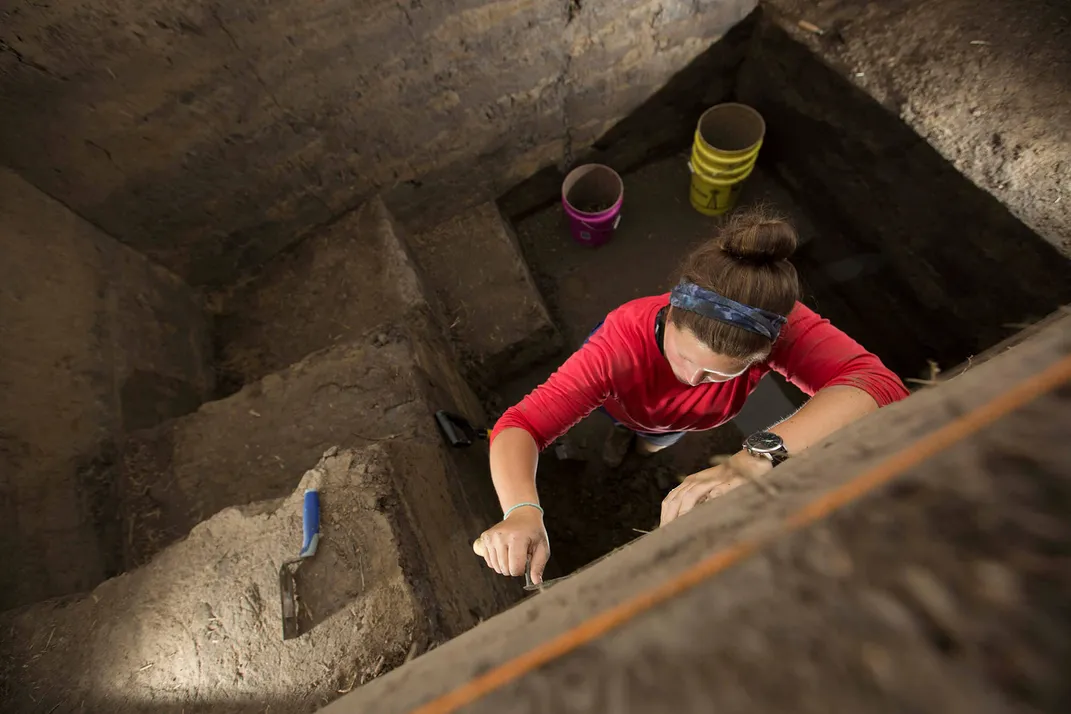Why Did Cahokia, One of North America’s Largest Pre-Hispanic Cities, Collapse?
A new study challenges the theory that resource exploitation led to the Mississippian metropolis’ demise
:focal(1775x1298:1776x1299)/https://tf-cmsv2-smithsonianmag-media.s3.amazonaws.com/filer/f8/86/f8860b65-0f89-42c6-a674-42184426dd6b/gettyimages-520122012.jpg)
At its peak around the turn of the first millennium, Cahokia, a city in what is now Illinois, was home to as many as 20,000 people. Members of North America’s Mississippian culture, Cahokia’s residents constructed enormous earthen mounds used alternatively as residences, burial grounds, meeting places and ceremonial centers. Per the Washington Post’s Nathan Seppa, the bustling community included farmers tasked with cultivating maize, artisans who crafted ornate clay vessels and sculptures, and even ancient astronomers who tracked the passage of time with the help of Stonehenge-like timber circles.
Cahokia grew from a small settlement established around 700 A.D. to a metropolis rivaling London and Paris by 1050. But just 200 years later, the once-thriving civilization had all but vanished, abandoning its patchwork collection of monumental earthworks for still-unknown reasons.
Theories regarding Cahokia’s demise run the gamut from environmental disasters to political clashes with neighboring groups. Given the lack of concrete evidence left behind by the Mississippians, scholars will likely never know exactly what led them to leave their home.
Still, new research appears to rule out at least one oft-cited explanation: As Glenn Hodges reports for National Geographic, a team led by Caitlin Rankin, an archaeologist at the University of Illinois at Urbana-Champaign, has found that the soil surrounding one of Cahokia’s mounds remained stable until the mid-1800s—centuries after the Mississippians’ departure. The analysis, published in the journal Geoarchaeology, refutes the idea that Cahokia’s inhabitants overharvested wood from the surrounding forests, sparking erosion and flooding that rendered the area uninhabitable.

“In this case, there was evidence of heavy wood use,” says Rankin in a statement. “But that doesn’t factor in the fact that people can reuse materials—much as you might recycle. We should not automatically assume that deforestation was happening, or that deforestation caused this event.”
Rankin began conducting excavations at Cahokia in 2017, when she was a doctoral student at Washington University in St. Louis, notes National Geographic. Upon studying soil samples collected near a creek at the site, she was surprised to find no traces of sediments associated with flooding. If the city’s ancient residents had, in fact, driven its ecosystem to doom through deforestation, the swath of low-lying land in question would almost certainly have flooded.
As Rankin tells National Geographic, the land overuse theory’s prevalence stems partly from Western-centric worldviews that conflate European colonizers’ exploitation of resources with Native American practices.
“That’s a Western mentality of resource exploitation—squeeze everything out of it that you can,” she explains. “[But] that’s not how it was in these Indigenous cultures.”
Scholars Neal Lopinot and William Woods of Southern Illinois University Edwardsville first proposed the land overuse theory in 1993. On the surface, the explanation makes sense: Cahokia’s infrastructure required ample amounts of wood, which was used to construct palisades, or log walls, as well as residential buildings and timber circles, according to Lee Bey of the Guardian. But while the Mississippians may have cut down tens of thousands of trees, the soil samples analyzed by Rankin suggest that these actions weren’t intensive enough to trigger civilization-ending flooding.
/https://tf-cmsv2-smithsonianmag-media.s3.amazonaws.com/filer/bc/53/bc5377ab-25b8-4b6e-999d-170c31cc18df/pbaf-09936_0377_2100-2048x1365.jpeg)
Because Cahokia’s inhabitants had no written language, researchers trying to puzzle out the metropolis’ mysteries must rely mainly on archaeological evidence. Clues come in many forms—among them human poop, as Lorraine Boissoneault wrote for Smithsonian magazine in 2018.
A.J. White, an archaeologist at the University of California, Berkeley, has spent the past several years studying coprostanol, a molecule produced in the gut when digesting food, to glean insights on Cahokia’s population over time. Last January, White and his colleagues published a study that similarly contradicts dominant narratives about the pre-Hispanic city. Far from remaining a “ghost town” in the centuries between its abandonment and modern rediscovery, Cahokia actually welcomed a new set of residents as early as 1500, per Kiona N. Smith of Ars Technica.
“[W]e were able to piece together a Native American presence in the area that endured for centuries,” said White in a 2020 statement.
Lopinot, one of the researchers who first raised the land overuse theory, tells National Geographic that he welcomes Rankin’s new take on the topic.
Ultimately, Lopinot adds, “Cahokia’s decline wasn’t something that happened overnight. It was a slow demise. And we don’t know why people were leaving. It might have been a matter of political factionalization, or warfare, or drought, or disease—we just don’t know.”
/https://tf-cmsv2-smithsonianmag-media.s3.amazonaws.com/accounts/headshot/mellon.png)
/https://tf-cmsv2-smithsonianmag-media.s3.amazonaws.com/accounts/headshot/mellon.png)